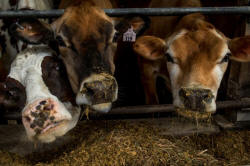U.S. dairy farmers get little help from Canada trade
deal
 Send a link to a friend
Send a link to a friend
 [October 25, 2018]
By Julie Ingwersen and Rod Nickel [October 25, 2018]
By Julie Ingwersen and Rod Nickel
MADISON, Wisconsin/ST. CLAUDE, Manitoba
(Reuters) - Minnesota farmer Paul Fritsche can no longer afford health
insurance as he struggles to sustain a dairy farm that has been in his
family for nearly a century.
With U.S. milk prices in the fourth year of a slump due to chronic
oversupply, Fritsche, 58, is unsure whether he will be able to pass his
30-cow farm onto his sons and grandsons.
"Do you pull the plug? We've been at it for 90 years," he said. "I'd
hate to lose that."
The dairy industry was a sticking point in the contentious
renegotiations of the free trade deal between the U.S., Canada and
Mexico that concluded last month.
U.S. President Donald Trump demanded concessions from the protected
Canadian dairy industry and said on Twitter that Canada was hurting U.S.
farmers with high tariffs. After Canada gave some ground, Trump claimed
a big victory and said farmers would have more export options.
But Canada opened less than 4 percent of its dairy market to U.S.
farmers - a concessions unlikely to make much of a dent in U.S.
oversupply or improve the lot of farmers such as Fritsche, producers on
both sides of the border say.

The U.S. Trade Representative - which negotiated the new deal that
replaced the North American Free Trade Agreement (NAFTA) with Mexico and
Canada - declined to comment. U.S. Agriculture Secretary Sonny Perdue
said in a statement Friday that the deal will "crack open" additional
dairy access and cited "significant victories" for U.S. agriculture.
In Canada, the dairy industry is faring much better and continues to be
among the nation's most profitable farm sectors, allowing most farmers
to absorb the concessions' impact. In addition, Ottawa has promised to
compensate dairy farmers for losses stemming from opening up the
industry.
Third-generation Canadian farmers Alain Philippot and Henry Holtmann are
each preparing to bring their children into the business. They say the
concessions sting and will limit growth. But the country's protectionist
system with its higher prices remains intact.
"I don't think there will be a mass exodus" of farmers, Holtmann said.
"There will be some leaving, but that's because their business models
weren't flexible enough."
DROWNING IN MILK
With Wisconsin alone producing more milk than is consumed in all of
Canada, the additional market access provides little comfort.
The average price that dairy plants pay U.S. farmers for milk fell from
a peak of $25 per hundred pounds (45.36 kilograms) in 2014 to about $16
now, according to the U.S. Department of Agriculture (USDA).
“The only thing that will help us is less milk or more consumption of
milk,” said Scooter LaPrise, 53, who with his wife has about 30 cows on
one of eight remaining dairy farms in Rhode Island.
“It’s not going to fix anything,” he said of the revamped trade
agreement. “It’s just something to catch votes.”
(For a Wider Image photo essay on U.S. dairy farmers, see: https://reut.rs/2JicGyI
)
While the more than 40,000 U.S. dairy farms have endured slumps before,
the current price slide has been unusually drawn-out as milk production
increased in recent years despite falling prices. Per capita consumption
of U.S. fluid milk has been falling steadily since the 1970s, although
total dairy consumption has increased as Americans eat more yogurt,
butter and cheese, according to the USDA.
The new arrangement with Canada likely won't pull U.S. dairy farmers out
of the ditch, said Mark Stephenson, director of dairy policy and
analysis at the University of Wisconsin.
"It does provide a bit more access to Canada," he said. "But it's pretty
incremental change."
PROTECTED MARKET
Canada has been an island of stability in an otherwise volatile global
industry. In July, farmers in the Canadian province of Ontario received
the equivalent of $24.20 per hundred pounds of milk, about 50 percent
more than U.S. farmers collect, according to data published by Dairy
Farmers of Ontario.
[to top of second column] |

Miss USA and two other dairy cows eat their breakfast after their
morning milking at EMMA Acres dairy farm, in Exeter, Rhode Island,
U.S., 7 April, 2018. REUTERS/Oliver Doyle

That's because Canada manages oversupply by issuing production quotas to farmers
based on domestic consumption, setting prices according to a formula that
factors in farm costs and imposing high tariffs to keep most imports out.
In 35 years of farming, St. Claude, Manitoba farmer Philippot has lost money
only "a handful" of times.
Since Holtmann and his brother took over the family dairy farm near Rosser,
Manitoba in 1995, they have expanded nine-fold, to 600 cows, which required them
to spend about C$14 million to purchase the right to produce more milk. The
system allows farmers to buy and sell units of production quota - based on 1
kilogram of butterfat per day, or nearly the output of one cow - which currently
fetch close to C$30,000 each at auction in Manitoba.
In a Statistics Canada profitability measure, dairy farmers' operating expenses
were 77 percent of gross farm receipts in 2015, the latest data available, the
healthiest level of 11 farm sectors.
That statistic does not include debt, however. Canadian dairy farmers in 2015
held the second-highest liabilities on average among Canadian farm sectors as
well as the third-highest net worth, according to Statistics Canada.
Farmers say concessions in recent trade deals will strain their profits and
leverage.
Dairy Farmers of Canada (DFC) estimates that the market share ceded to the
United States, as well as in trade deals with the European Union and Pacific
nations, will add up to 18 percent by 2024, worth C$1.3 billion.
"Is it impossible to get over that? No. But it's like losing a finger, and then
another one," said Philippot at his small 68-cow farm.

Canada also agreed in trade talks with the United States to dismantle a pricing
system for the lower-value skim portion of milk that previously allowed Canadian
skim to displace U.S. ingredients in the production of cheese and yogurt.
Philippot says that move will reduce the prices farmers receive for milk.
Canada's combined concessions could mean reductions to Canadian dairy farmers'
quotas, since production is matched to domestic consumption, less imports.
Domestic consumption growth, however, estimated at 2 percent annually by DFC for
the next six years, offsets some of the lost share to imports and mitigates any
reduced quotas.
LaPrise expressed admiration for Canada's "really good milk system."
"When a Canadian dairy farmer wants to retire he sells his quota and he can
retire on that," he said.
'BACK IN THE HOLE'
U.S. dairy farmers have sought additional revenue with second jobs, harvesting
grain and dabbling in genetics by selling cows, bulls and embryos.
Many farmers couldn't get by without such side jobs, said Julie Brodeur of West
Kingston, Rhode Island. Brodeur and her brothers, fourth-generation dairy
farmers, quit the business in March after their 70-cow operation stopped
generating enough income to keep the cows fed.
"You borrow some more and then you pay everything off," Brodeur said. "And you
think everything is going good. And then you're back in the hole."
(Reporting by Julie Ingwersen in Madison, Wisconsin and Rod Nickel in St.
Claude, Manitoba; additional reporting by Humeyra Pamuk in Washington and
Caroline Stauffer in Chicago; editing by Denny Thomas, Simon Webb and Brian
Thevenot)
[© 2018 Thomson Reuters. All rights
reserved.] Copyright 2018 Reuters. All rights reserved. This material may not be published,
broadcast, rewritten or redistributed.
Thompson Reuters is solely responsible for this content. |